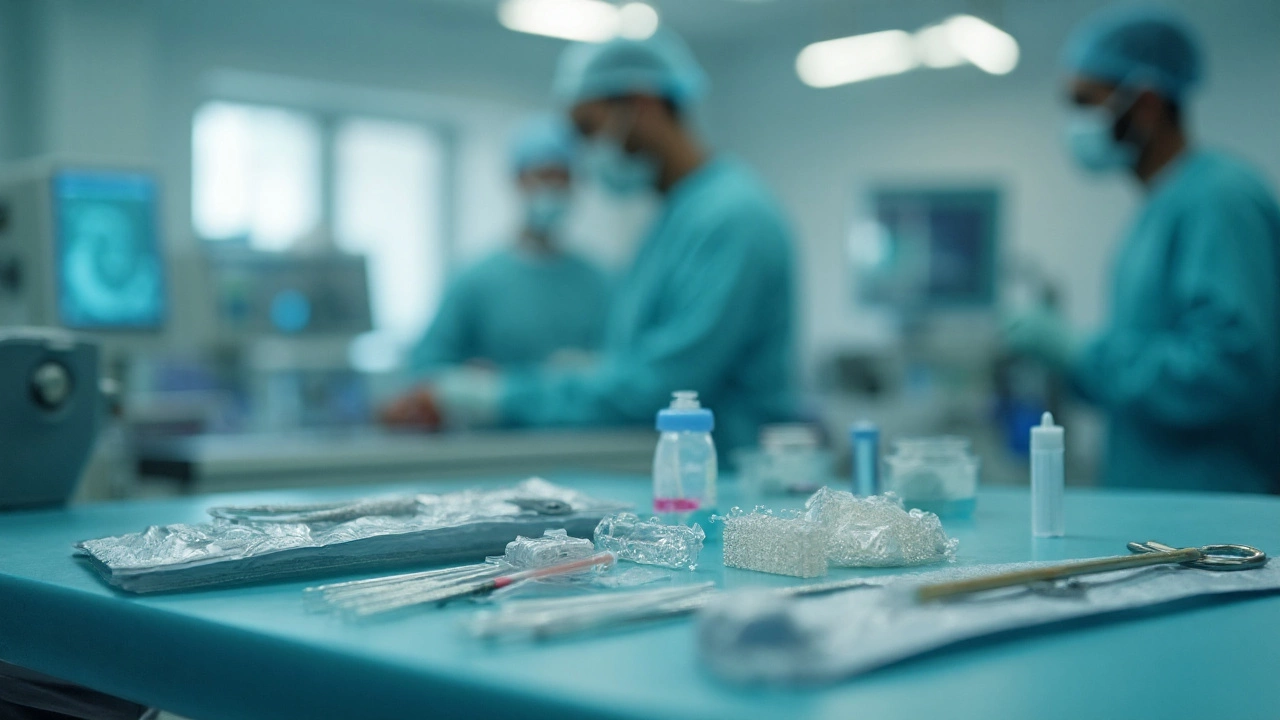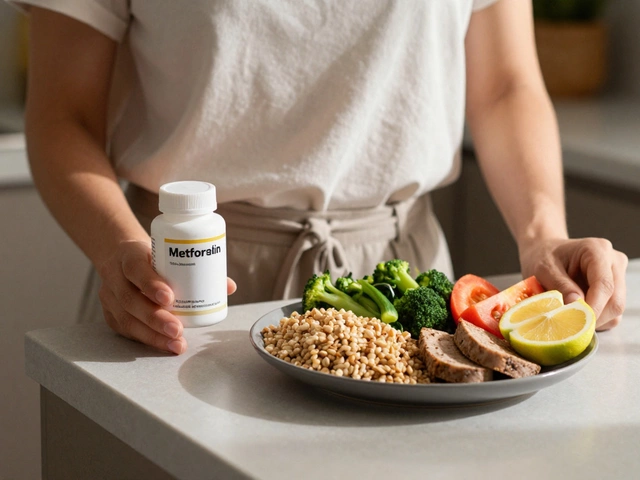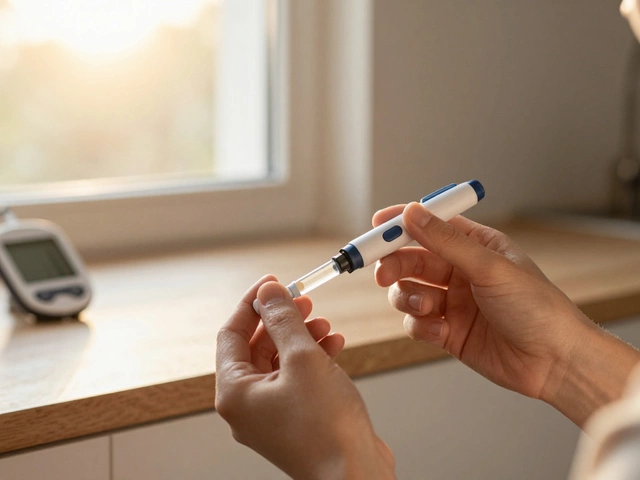- Home
- Orthopedics
- Newest Alternatives to Knee Replacement in 2025: GAE, Arthrosamid, MISHA, Agili‑C, and RFA Explained

Newest Alternatives to Knee Replacement in 2025: GAE, Arthrosamid, MISHA, Agili‑C, and RFA Explained
You want to avoid a knee replacement but still walk pain-free, sleep through the night, and get your life back. Here’s the honest 2025 picture: there are newer options that can delay or sometimes sidestep a total knee replacement, but they work best in the right patients and at the right stage of arthritis. Some buy you months, some years, and a few rebuild tissue. I live in London, I’m in my 40s, and I want to keep up with my son, Devansh, on weekend kickabouts-so I pay attention to what actually helps knees hold up in real life, not just in studies.
TL;DR - What is the newest alternative to knee replacement?
- The newest, genuinely different option for painful knee osteoarthritis is genicular artery embolization (GAE). It shrinks inflamed blood vessels in the knee lining to reduce pain. Early RCTs and registries show meaningful pain relief in many patients for 1-3 years, with a low complication rate. It’s available privately in the UK; NHS use is still limited and under special arrangements.
- Other notable 2025 options: Arthrosamid (a one-time hydrogel injection that can last 2-3 years), cooled radiofrequency ablation (RFA) of genicular nerves (6-12 months relief on average), MISHA Knee System (meniscus replacement for post-meniscectomy pain), and Agili‑C (a cartilage-bone scaffold for focal wear, FDA-approved in 2023, rolling out in select centres).
- Who they help: best for mild-moderate osteoarthritis or specific problems (bone marrow lesions, meniscus loss, focal cartilage defects). If you’re “bone-on-bone” everywhere, these are less likely to beat a good knee replacement.
- Safety and recovery: most are day-case with quick recovery (days to weeks). Serious complications are rare but not zero (skin issues with GAE, numbness or neuritis after RFA, implant-related risks with MISHA/Agili‑C).
- Costs in the UK (private): Arthrosamid £1.8k-£3k; RFA £3k-£6k; GAE £6k-£10k; MISHA/Agili‑C/osteotomy £8k-£15k+. NHS coverage is uneven; ask about local pathways and trials.
What’s actually new in 2025? Your options, evidence, and who they suit
New doesn’t always mean better, and “better” depends on your knee’s stage, alignment, and goals. Here are the modern alternatives with the strongest real-world momentum this year, what they are, who they fit, and what the evidence says.
1) Genicular Artery Embolization (GAE)
What it is: A minimally invasive radiology procedure. A tiny catheter is threaded from the wrist or groin into the small knee arteries. The doctor injects microscopic particles to reduce abnormal blood flow that fuels inflammation and pain in the synovium (the knee lining).
- Best for: Mild to moderate osteoarthritis with significant synovitis (warm, swelling, activity-related pain). Often those not yet ready for replacement and not responding to physio, NSAIDs, or injections.
- Evidence: Prospective studies and early randomized trials show significant improvements in pain and function at 6-24 months for a majority of patients, with sustained benefits in many to 3 years. Complications are uncommon and usually minor (skin discoloration, transient pain). UK guidance currently suggests using it under governance and audit.
- What it feels like: Day procedure, local anesthesia plus sedation; home the same day.
- Recovery: Walk the same day; gradual improvement over weeks as inflammation falls.
- Risks: Small risk of nontarget embolization causing skin changes or temporary pain flare; rare infection or vessel issues.
- Availability (UK): Growing in private hospitals and select NHS centres within evaluation pathways.
2) Arthrosamid (polyacrylamide hydrogel, 2.5%)
What it is: A single, gel-like injection into the knee joint that integrates with the synovial lining and improves lubrication and cushioning. Different to hyaluronic acid-this is a long-lasting hydrogel that doesn’t break down quickly.
- Best for: Mild-moderate osteoarthritis (Kellgren-Lawrence grade 2-3) with activity-related pain and stiffness.
- Evidence: European studies and UK real-world data show meaningful pain and function improvements that can last 24-36 months for many. Adverse events are uncommon and usually transient swelling or soreness.
- Recovery: Back to normal light activity within days; effects build over weeks.
- Risks: Flare, swelling; rare infection. Not a fit for severe, tricompartmental bone-on-bone.
- Availability (UK): Widely available privately; not routinely funded on the NHS.
3) Cooled Radiofrequency Ablation (RFA) of the genicular nerves
What it is: Targeted heat (via a small probe) “stuns” pain-carrying nerves around the knee. The cooled version creates a larger, more consistent lesion.
- Best for: Patients with pain out of proportion to imaging, or not suitable for surgery; also used to delay surgery or for persistent pain after arthroscopy.
- Evidence: Multiple randomized trials (2018 onward) show higher responder rates vs. steroid injections, with 50-70% of patients getting at least 50% pain relief at 6 months; some maintain benefit to 12 months or more, but it often wears off.
- Recovery: Immediate weight-bearing; mild soreness for a few days.
- Risks: Temporary numbness, neuritis, rare burns or infection.
- Availability (UK): Offered in pain clinics; NHS access varies by trust.
4) iovera° cryoneurolysis
What it is: A handheld device freezes small sensory nerves near the knee to shut off pain signals temporarily.
- Best for: Short-term pain control (3-5 months typical), e.g., to get through a holiday season, weight-loss phase, or a physio programme. Also used pre-TKA to reduce post-op pain.
- Evidence: RCTs show better pain control than sham in the short term; effect fades as nerves regrow.
- Recovery: Immediate walking; quick return to activity.
- Risks: Temporary numbness; rare bruising or dysesthesia.
5) MISHA Knee System (meniscus replacement)
What it is: A synthetic meniscus implant used to replace a damaged or removed medial meniscus in people with persistent pain after meniscectomy.
- Best for: Patients (often 30s-50s) with pain after medial meniscectomy, localized to the inner knee, with relatively preserved cartilage and alignment.
- Evidence: FDA granted De Novo authorization in 2023 based on prospective data showing clinically meaningful pain and function gains vs. non-surgical care. Mid-term survivorship is encouraging; revision/implant issues can occur.
- Recovery: Typically protected weight-bearing initially; months to full activity.
- Risks: Implant failure, synovitis, need for revision or later arthroplasty.
- Availability (UK): Limited centres; more common in specialized private/European clinics.
6) Agili‑C (CartiHeal) osteochondral scaffold
What it is: A porous aragonite-based implant that fills a focal cartilage and underlying bone defect, encouraging natural repair.
- Best for: Focal cartilage defects or early osteoarthritis in a limited area (not widespread bone-on-bone), often medial compartment.
- Evidence: A pivotal randomized trial showed superior outcomes vs. microfracture/debridement at 2 years in both younger and older cohorts, leading to FDA approval in 2023.
- Recovery: Weeks to months, with protected loading and rehab.
- Risks: Graft-related failure, persistent pain, need for reoperation.
- Availability (UK): Rolling out in select centres; ask about trials/private options.
7) Autologous orthobiologics (PRP, APS/nStride, BMAC, microfragmented fat)
What they are: Injections using your own blood or cells to reduce inflammation and support joint health.
- PRP (platelet-rich plasma): Good evidence for mild-moderate OA symptom relief, often outperforming hyaluronic acid. Best results with leukocyte-poor PRP in 2-3 injections. Benefits often last 6-12 months.
- APS/nStride: A concentrated anti-inflammatory protein solution from your blood. RCTs show stronger pain reduction than saline at 12 months; growing UK use.
- BMAC/fat (MFAT): Evidence is mixed and technique-dependent. In the UK, advanced cell manipulations are tightly regulated; be wary of “stem cell cure” claims.
8) Subchondroplasty (SCP) for bone marrow lesions
What it is: A targeted injection of flowable calcium phosphate into painful bone marrow lesions under X-ray guidance.
- Best for: Sharp, weight-bearing pain with MRI-proven bone marrow lesions in early-to-moderate OA.
- Evidence: Cohort studies show pain relief and reduced progression to arthroplasty at 1-2 years in many patients; RCT data are limited.
- Recovery: Usually rapid return to walking; soreness for days.
9) Alignment and joint-preserving surgery (High Tibial Osteotomy, Unloading braces, Partial Knee)
Not brand-new, but still the right “alternative” for the right knee.
- High Tibial Osteotomy (HTO): For bow-legged (varus) knees with medial compartment wear. Realigns load; can forestall replacement for years in active 40s-50s.
- Unicompartmental (partial) knee replacement: Smaller surgery than total knee, faster recovery, very effective if only one compartment is damaged.
- Unloading braces: Cheap, safe, and can make walking bearable while you get fitter or wait for other care.
Quick credibility check: The options above are backed by peer-reviewed trials or multi-centre registries: RFA (randomized trials with 6-12 month durability), GAE (prospective cohorts, early RCTs, and national guidance under evaluation), Arthrosamid (2-3 year outcomes), MISHA and Agili‑C (US approvals after pivotal data). None is magic; all work better when matched to the right knee.

How to choose: a simple path that respects your knee’s stage
Use this shortlist to match your situation. If you have recent X-rays (Kellgren-Lawrence grade) or MRI, even better. If not, start with an X-ray and a good exam.
- Early OA (KL 1-2), focal pain, active lifestyle: Consider PRP (2-3 sessions), APS/nStride, Arthrosamid, targeted physio (hip/glute strength, gait tweaks), weight loss if BMI>27. If MRI shows a focal defect, ask about Agili‑C or MACI. If you had a meniscectomy and pain is medial, ask about MISHA.
- Moderate OA (KL 2-3), swelling/synovitis, night aches: Consider GAE or Arthrosamid. RFA or iovera° if you need pain control to rehab or lose weight. If MRI shows bone marrow lesions, discuss Subchondroplasty.
- Varus knees with medial wear but not bone-on-bone: Consider HTO to offload. This is the most durable “alternative” for the right patient profile.
- Severe, multi-compartment OA (KL 4): You can try RFA/Arthrosamid/GAE for a temporary bridge, but a well-done total knee often wins on durability and function.
- Pain after meniscectomy with preserved cartilage: MISHA Knee System or unloading bracing. Confirm alignment and cartilage status first.
Decision rules of thumb
- If swelling is your main complaint, GAE or Arthrosamid is more logical than nerve ablation.
- If pain is “sharp electric” with steps and eases at rest, RFA or iovera° can be a good bridge to get you moving again.
- If X-ray says “bone-on-bone everywhere,” skip months of injections and have a serious talk about partial/total knee options.
- If you’re under 55 and bow-legged with medial wear, ask early about HTO. It preserves biology and options later.
- Never buy into “stem cell cures.” Ask for published evidence and regulatory status in the UK.
| Option | Best for | Typical relief window | Evidence snapshot | Recovery | UK availability | Private cost (GBP) |
|---|---|---|---|---|---|---|
| GAE | KL 2-3 with synovitis | 12-36 months | Prospective cohorts + early RCTs; low serious AE rate | Same-day walk; weeks to full effect | Private; limited NHS under evaluation | £6,000-£10,000 |
| Arthrosamid | KL 2-3 symptomatic OA | 18-36 months | 2-3 year outcome data; low AE | Days | Private; limited NHS | £1,800-£3,000 |
| Cooled RFA | Pain-driven OA, surgery delay | 6-12 months | Multiple RCTs vs. steroid; good responders | Days | Private; some NHS pain clinics | £3,000-£6,000 |
| iovera° cryo | Short-term pain control | 3-5 months | RCTs show short-term benefit | Same day | Private clinics | £600-£1,200 |
| MISHA Knee System | Post-meniscectomy pain | Years (mid-term data) | FDA De Novo 2023; prospective studies | Months | Limited centres | £10,000-£18,000 |
| Agili‑C | Focal cartilage/bone defects | Years (ongoing) | Pivotal RCT; FDA 2023 | Months | Select centres | £8,000-£15,000+ |
| Subchondroplasty | MRI bone marrow lesions | 1-2+ years | Cohort data; limited RCTs | Days-weeks | Specialist centres | £4,000-£7,000 |
Pitfalls to avoid
- Skipping imaging: An MRI can reveal bone marrow lesions or focal defects that change the plan entirely.
- Chasing injections in KL 4: When all compartments are bone-on-bone, most injections are stopgaps at best.
- Ignoring alignment: A bow-legged knee will keep crushing the inner compartment unless you unload it.
- Buying “stem cell miracle” packages: Ask for randomized trials, regulatory approval, and published outcomes.
Pro tips from the clinic floor
- Combine treatments thoughtfully: RFA or iovera° can give a pain window to build strength, drop weight, and make injections or bracing work better.
- Track with a simple score: Fill a KOOS or WOMAC every 6-8 weeks so you can see if a treatment actually moved the needle.
- If you’re on the fence: A trial of an unloading brace for 6 weeks gives quick feedback on whether offloading surgery (HTO, partial) might help.
FAQs you’re probably asking
- What is the newest alternative to knee replacement? The headline “new” option in 2025 is GAE. Also newish: Arthrosamid hydrogel, MISHA meniscus replacement, and Agili‑C cartilage scaffold.
- Does GAE replace a knee replacement? No. It can delay or reduce pain for 1-3 years in the right knees. If you progress to severe tricompartment disease, replacement still tends to win on durability.
- Is Arthrosamid better than hyaluronic acid? For many, yes. It’s a one-off gel designed to last years, not months. Not a fit for advanced bone-on-bone.
- How long does RFA last? Commonly 6-12 months. It can be repeated. Ideal for pain-dominant cases to help you train, sleep, and function.
- Is stem cell therapy legit? The term is abused. Some cell-based injections show promise, but many offerings are unregulated or overhyped. In the UK, advanced cell therapies have strict rules. Ask for peer-reviewed trials and regulatory status.
- What if my pain is from a bad meniscus surgery years ago? If cartilage is reasonably preserved and pain is medial, the MISHA Knee System could be an option. You’ll need specialist assessment and imaging.
- What about weight loss? Even 5-10% body weight reduction cuts knee load and pain. Pair it with targeted strengthening and any of the options above works better.
- Can I get these on the NHS? Some, sometimes. RFA and GAE are available in certain trusts under governance pathways. Arthrosamid, MISHA, and Agili‑C are mainly private today. Always ask about trials.
- Are these safe for diabetics or people on blood thinners? Many are, but specifics matter. GAE and surgery may require anticoagulation plans. Always run meds and comorbidities past your team.

Next steps and realistic game plans
Here are clear action paths based on common scenarios I see in London clinics.
Scenario A: 45-55, runner or football parent, early OA (KL 1-2)
- Get a weight-bearing X-ray; consider MRI if symptoms don’t match X-ray.
- Start 8-12 weeks of physio: hip/glute strength, calf/hamstring mobility, cadence tweaks for running.
- Discuss PRP (2-3 sessions) or APS; consider Arthrosamid if pain persists and you want a one-off option.
- If MRI shows a focal defect, ask about Agili‑C/MACI. If post-meniscectomy and medial pain, discuss MISHA.
Scenario B: 55-70, moderate OA (KL 2-3), daily swelling, stairs hurt
- Check alignment on X-ray. If varus, try an unloading brace for 6 weeks-predicts benefit from HTO/partial.
- If swelling dominates, shortlist GAE or Arthrosamid. If night pain blocks sleep, add RFA or iovera° for a pain window.
- If MRI shows bone marrow lesions, add Subchondroplasty to the discussion.
- Reassess at 3 months with KOOS/WOMAC. If still stuck and wear is localized, consider HTO or partial knee.
Scenario C: 65-80, severe OA (KL 4), struggling to walk to the shops
- Have an honest talk about partial/total knee replacement. A well-done replacement often restores reliable function.
- If you need time to get fit or manage other health issues, consider RFA or Arthrosamid as a bridge. GAE may help if swelling is intense.
- Use a cane contralaterally (opposite hand) and do prehab-quads, balance, step training-to make surgery easier.
How to choose a provider (UK checklist)
- Ask how many of the specific procedure they did last year and their complication rate.
- Ask what KOOS/WOMAC improvement they consider a “win” and what percentage of patients achieve it.
- Confirm the plan if the first option fails (e.g., RFA → GAE → partial knee).
- Check if they audit outcomes and contribute to a registry. Walk away from vague answers.
What I’d personally do before saying yes to surgery
- Get updated, weight-bearing X-rays; add MRI if symptoms don’t match.
- Try 8-12 weeks of targeted physio and a 5-10% weight loss push (if applicable).
- Choose one primary intervention aligned with my knee’s profile: GAE for hot, swollen knees; Arthrosamid if I want one shot; RFA if pain is the main limiter and I need quick function.
- Set a 12-week review. If I’m not at least 30% better on a validated score, I pivot.
None of these options is a silver bullet. The win is picking the right tool for your knee, using it to unlock rehab and daily activity, and measuring progress so you know when to change course. That’s how you really buy back years before a knee replacement becomes the sensible, durable choice.

Arnav Singh
I am a health expert with a focus on medicine-related topics in India. My work involves researching and writing articles that aim to inform and educate readers about health and wellness practices. I enjoy exploring the intersections of traditional and modern medicine and how they impact healthcare in the Indian context. Writing for various health magazines and platforms allows me to share my insights with a wider audience.
About
Medical Resource Center India is a comprehensive online platform dedicated to providing reliable health information and medical resources in India. Explore a wide range of articles, tips, and advice on medicine, healthcare services, and wellness. Stay informed about the latest developments in Indian medicine and access valuable insights into maintaining a healthy lifestyle. Discover expert guidance and health solutions tailored for every Indian citizen. Your go-to destination for authoritative medical knowledge in India.




